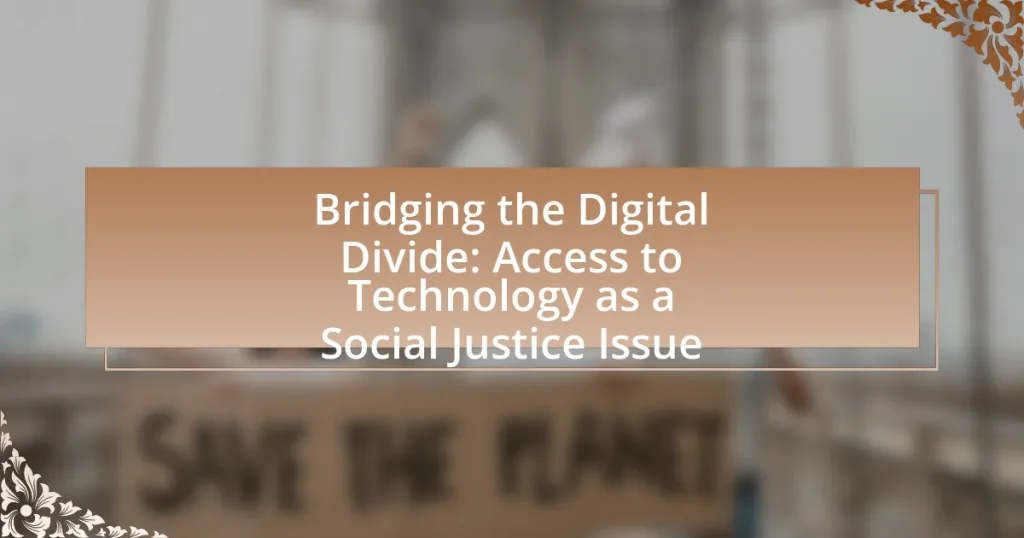The article focuses on the Digital Divide, which is the gap between individuals and communities with access to modern information and communication technology and those without. It highlights the importance of addressing this divide as it significantly impacts economic opportunities, educational access, and social inclusion, particularly for marginalized communities. Key factors contributing to the Digital Divide include socio-economic disparities, geographic location, and digital literacy, which collectively hinder access to technology and exacerbate social inequities. The article also discusses various initiatives and policies aimed at bridging this divide, emphasizing the role of community involvement and advocacy in promoting equitable access to technology as a critical social justice issue.
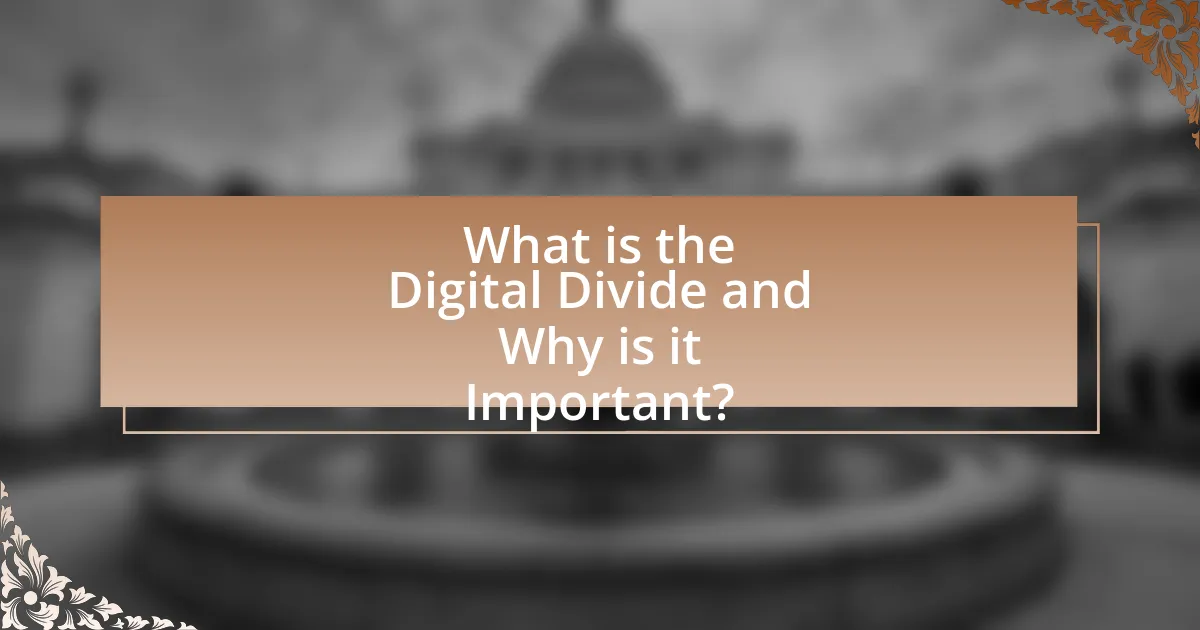
What is the Digital Divide and Why is it Important?
The Digital Divide refers to the gap between individuals and communities that have access to modern information and communication technology and those that do not. This divide is important because it affects economic opportunities, educational access, and social inclusion, leading to disparities in quality of life and participation in the digital economy. According to the Pew Research Center, as of 2021, approximately 30% of lower-income households in the United States lacked broadband internet access, highlighting the significant impact of this divide on marginalized communities. Addressing the Digital Divide is crucial for promoting equity and ensuring that all individuals can benefit from technological advancements.
How does the Digital Divide impact different communities?
The Digital Divide significantly impacts different communities by creating disparities in access to technology and the internet, which in turn affects education, employment, and healthcare opportunities. For instance, communities with limited internet access often struggle to participate in remote learning, leading to lower educational outcomes; a report from the Pew Research Center indicates that 35% of lower-income households lack high-speed internet, hindering students’ ability to complete assignments and engage in online learning. Additionally, job seekers in these communities face challenges in applying for positions or accessing online training resources, as 80% of jobs are now found online, according to the U.S. Department of Labor. Furthermore, limited access to telehealth services exacerbates health disparities, as individuals in underserved areas may not have the means to consult healthcare providers remotely, impacting their overall well-being.
What are the socio-economic factors contributing to the Digital Divide?
The socio-economic factors contributing to the Digital Divide include income inequality, education levels, and geographic location. Income inequality affects individuals’ ability to afford technology and internet services; for instance, households with lower incomes often lack access to high-speed internet, which is essential for digital engagement. Education levels also play a critical role, as individuals with higher education are more likely to possess digital skills and access technology, while those with lower educational attainment may struggle to utilize digital resources effectively. Geographic location further exacerbates the divide, as rural areas frequently have limited infrastructure for internet connectivity compared to urban regions, leading to disparities in access. According to the Pew Research Center, 25% of adults in lower-income households do not have a smartphone, compared to only 5% in higher-income households, illustrating the impact of income on technology access.
How does geographic location influence access to technology?
Geographic location significantly influences access to technology by determining the availability of infrastructure, resources, and services. Urban areas typically have better internet connectivity, higher bandwidth, and more technology resources compared to rural regions, where limited infrastructure can hinder access. For instance, according to the Federal Communications Commission (FCC), as of 2021, approximately 14 million Americans in rural areas lack access to high-speed internet, compared to only about 1 million in urban areas. This disparity illustrates how geographic location directly impacts the ability of individuals and communities to access essential technological tools and services, thereby contributing to the digital divide.
What role does technology play in social justice?
Technology plays a crucial role in advancing social justice by providing tools for communication, education, and advocacy. It enables marginalized communities to access information, connect with allies, and mobilize for change. For instance, social media platforms have been instrumental in organizing movements such as Black Lives Matter, allowing for widespread awareness and engagement on issues of racial inequality. Additionally, access to technology can bridge educational gaps; studies show that students with reliable internet access perform better academically, highlighting the importance of equitable access to technology in promoting social justice.
How can access to technology empower marginalized groups?
Access to technology can empower marginalized groups by providing them with essential tools for education, economic opportunities, and social connectivity. For instance, access to the internet enables individuals from these groups to participate in online learning, which can lead to improved job prospects; a study by the Pew Research Center found that 73% of students from low-income families reported that access to technology was crucial for their educational success. Furthermore, technology facilitates access to information and resources that can help marginalized communities advocate for their rights and engage in civic activities, thereby enhancing their social and political power.
What are the consequences of limited access to technology on social equity?
Limited access to technology significantly exacerbates social inequity by hindering opportunities for education, employment, and civic engagement. Individuals without reliable technology access face barriers in acquiring digital literacy skills, which are increasingly essential in the job market; for instance, a report by the Pew Research Center indicates that 82% of job seekers use online resources to find employment. Furthermore, students lacking access to technology are at a disadvantage in remote learning environments, leading to lower academic performance and reduced future earning potential. This digital divide perpetuates existing inequalities, as marginalized communities are disproportionately affected, limiting their ability to participate fully in society and access essential services.
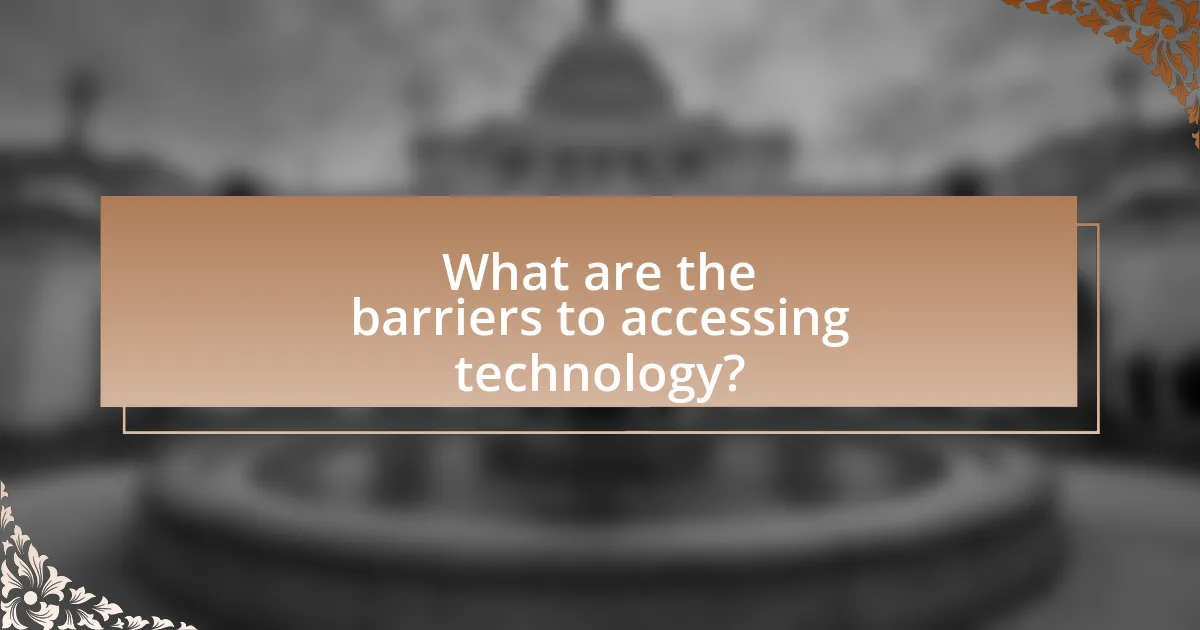
What are the barriers to accessing technology?
Barriers to accessing technology include economic factors, lack of infrastructure, digital literacy, and social inequalities. Economic factors, such as the high cost of devices and internet services, prevent many individuals from obtaining necessary technology. Lack of infrastructure, particularly in rural or underserved areas, limits access to reliable internet connections. Digital literacy is another significant barrier, as individuals without the skills to navigate technology are unable to utilize available resources effectively. Additionally, social inequalities, including race, gender, and disability, exacerbate these issues, leading to a disproportionate impact on marginalized communities. According to the Pew Research Center, 25% of adults in lower-income households report not having a smartphone, highlighting the economic barrier to technology access.
How do financial constraints affect technology access?
Financial constraints significantly limit technology access by restricting individuals and communities from purchasing necessary devices and services. For instance, a report by the Pew Research Center indicates that 29% of lower-income households in the United States lack access to high-speed internet, which is essential for educational and professional opportunities. This lack of access perpetuates inequalities, as those unable to afford technology are excluded from digital resources, online learning, and job opportunities that require internet connectivity. Consequently, financial barriers create a cycle of disadvantage, hindering social mobility and exacerbating the digital divide.
What are the costs associated with obtaining technology?
The costs associated with obtaining technology include initial purchase prices, ongoing maintenance expenses, and potential subscription fees for software and services. Initial purchase prices can vary widely; for example, a basic laptop may cost around $300, while high-end models can exceed $2,000. Ongoing maintenance expenses, such as repairs and upgrades, can add an additional 10-20% of the initial cost annually. Subscription fees for software services, like cloud storage or productivity tools, can range from $5 to $50 per month, depending on the service. These financial factors contribute to the overall economic barrier that individuals and communities face in accessing technology, highlighting the importance of addressing these costs in efforts to bridge the digital divide.
How does income inequality exacerbate the Digital Divide?
Income inequality exacerbates the Digital Divide by limiting access to technology and internet services for lower-income individuals. Those with higher incomes can afford devices, high-speed internet, and digital literacy training, while those in lower income brackets often cannot, resulting in a significant gap in digital access. According to the Pew Research Center, as of 2021, 44% of households earning less than $30,000 annually lacked broadband internet, compared to only 5% of households earning over $75,000. This disparity in access to technology perpetuates socioeconomic inequalities, as individuals without reliable internet are at a disadvantage in education, employment, and access to essential services.
What are the educational barriers to technology access?
Educational barriers to technology access include lack of infrastructure, insufficient funding, and inadequate digital literacy. Lack of infrastructure refers to the absence of reliable internet connectivity and access to devices, which disproportionately affects low-income and rural areas. Insufficient funding limits schools’ ability to purchase necessary technology and maintain it, creating disparities in educational opportunities. Inadequate digital literacy among students and educators further exacerbates these issues, as individuals may not possess the skills needed to effectively utilize technology for learning. According to a report by the Pew Research Center, 15% of U.S. households with school-age children do not have a high-speed internet connection, highlighting the significant impact of these barriers on education.
How does the lack of digital literacy impact technology use?
The lack of digital literacy significantly hinders effective technology use. Individuals with low digital literacy struggle to navigate digital platforms, leading to decreased access to information, services, and opportunities. For instance, a report by the Pew Research Center indicates that 14% of Americans do not use the internet, primarily due to a lack of skills, which limits their ability to engage in online education, job applications, and essential services. This gap in digital skills exacerbates social inequalities, as those lacking proficiency are unable to fully participate in a technology-driven society, reinforcing the digital divide.
What role do schools play in bridging the Digital Divide?
Schools play a crucial role in bridging the Digital Divide by providing access to technology and digital literacy education. They serve as essential hubs where students from diverse socioeconomic backgrounds can gain exposure to computers, the internet, and various digital tools. According to the National Center for Education Statistics, approximately 14% of students in the U.S. lack access to high-speed internet at home, highlighting the importance of schools in offering resources that facilitate digital engagement. By integrating technology into the curriculum and ensuring equitable access to devices, schools help to level the playing field, enabling all students to develop the necessary skills for success in a technology-driven world.
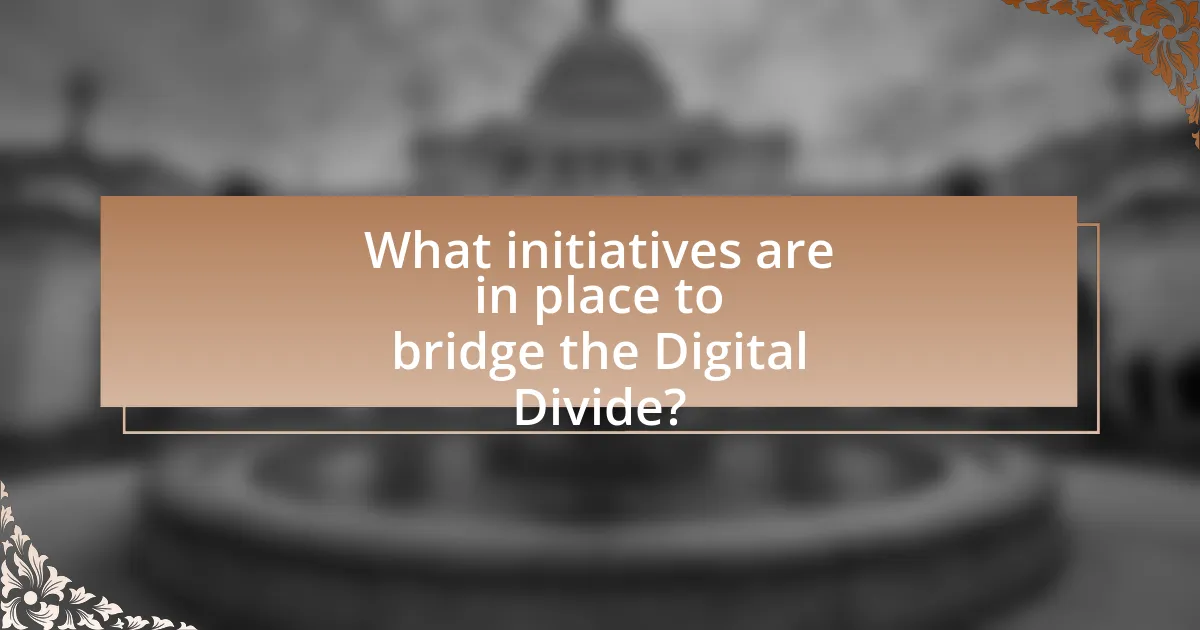
What initiatives are in place to bridge the Digital Divide?
Various initiatives are in place to bridge the Digital Divide, including government programs, nonprofit efforts, and private sector collaborations. For example, the Federal Communications Commission (FCC) in the United States has implemented the Lifeline program, which provides discounted phone and internet services to low-income households, helping to increase access to essential digital resources. Additionally, organizations like EveryoneOn work to connect low-income families with affordable internet service and digital literacy training, aiming to empower individuals with the skills needed to navigate the digital world. Furthermore, tech companies such as Microsoft have launched initiatives like Airband, which focuses on expanding broadband access in underserved rural areas, thereby addressing geographical disparities in internet connectivity. These initiatives collectively aim to reduce the gap in technology access and promote social equity.
How are governments addressing technology access issues?
Governments are addressing technology access issues through initiatives aimed at expanding broadband infrastructure and providing subsidies for low-income households. For example, the Federal Communications Commission (FCC) in the United States has implemented the Affordable Connectivity Program, which offers discounts on internet services to eligible families, thereby increasing access to essential online resources. Additionally, many governments are investing in public Wi-Fi networks and partnering with private companies to enhance connectivity in underserved areas, as seen in various state-level programs across the U.S. and Europe. These efforts are crucial in narrowing the digital divide and ensuring equitable access to technology for all citizens.
What policies have been implemented to improve access to technology?
Policies implemented to improve access to technology include the Federal Communications Commission’s (FCC) E-Rate program, which provides discounts to schools and libraries for internet access and telecommunications services. This program has facilitated connectivity for over 90% of U.S. schools and libraries, significantly enhancing digital access in underserved areas. Additionally, the Affordable Connectivity Program (ACP) offers subsidies to low-income households to reduce the cost of internet service, aiming to bridge the digital divide. According to the National Digital Inclusion Alliance, these initiatives have collectively increased broadband adoption rates among marginalized communities, demonstrating their effectiveness in promoting equitable access to technology.
How effective are these policies in reducing the Digital Divide?
These policies are effective in reducing the Digital Divide by increasing access to technology and internet services for underserved populations. For instance, initiatives like the Federal Communications Commission’s Lifeline program have provided subsidies for low-income households, resulting in a 20% increase in broadband adoption among eligible participants. Additionally, community programs that offer digital literacy training have shown to improve technology usage skills, further bridging the gap. Studies indicate that areas with targeted policy interventions experience a significant reduction in the disparity of internet access, highlighting the positive impact of these measures on social equity.
What role do non-profit organizations play in bridging the Digital Divide?
Non-profit organizations play a crucial role in bridging the Digital Divide by providing access to technology and digital literacy training to underserved communities. These organizations often implement programs that distribute devices, such as computers and tablets, and offer internet access in areas where it is limited or non-existent. For instance, the National Digital Inclusion Alliance reports that non-profits have been instrumental in increasing broadband adoption rates among low-income households by facilitating access to affordable internet services. Additionally, non-profits like EveryoneOn focus on educating individuals about digital skills, which is essential for navigating the increasingly digital world. By addressing both access and education, non-profit organizations effectively contribute to reducing disparities in technology access and usage.
What programs are available to provide technology access to underserved communities?
Programs available to provide technology access to underserved communities include the ConnectHome initiative, which aims to provide affordable internet access and digital literacy training to low-income families in public housing. Additionally, the EveryoneOn program focuses on connecting low-income individuals to low-cost internet service and devices, while also offering digital skills training. The Digital Equity Act, introduced in the U.S. Congress, seeks to promote digital equity by funding initiatives that enhance technology access in underserved areas. These programs are supported by various statistics, such as the fact that nearly 30% of households in low-income areas lack internet access, highlighting the critical need for such initiatives.
How do partnerships between organizations enhance technology access?
Partnerships between organizations enhance technology access by pooling resources, expertise, and networks to create more comprehensive solutions. For instance, collaborations between tech companies and non-profits can lead to initiatives that provide underserved communities with affordable internet and devices. A notable example is the partnership between Microsoft and various local governments, which has resulted in programs aimed at increasing broadband access in rural areas, thereby reducing the digital divide. Such collaborations leverage the strengths of each partner, enabling them to address barriers to technology access more effectively than they could individually.
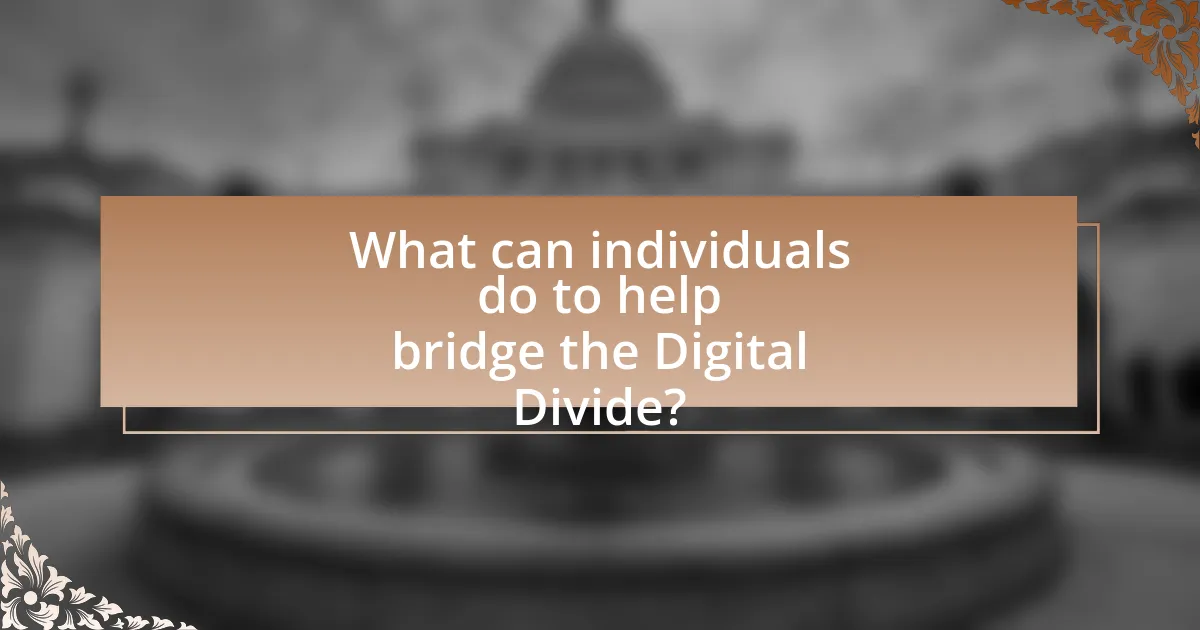
What can individuals do to help bridge the Digital Divide?
Individuals can help bridge the Digital Divide by advocating for equitable access to technology and digital literacy programs. By supporting local initiatives that provide internet access and affordable devices, individuals can directly contribute to reducing disparities. For instance, research from the Pew Research Center indicates that communities with increased access to technology see improved educational and economic outcomes. Additionally, volunteering to teach digital skills in underserved areas empowers individuals to navigate the digital landscape effectively, further closing the gap.
How can community involvement make a difference?
Community involvement can make a significant difference by fostering collaboration and resource sharing to address the digital divide. When local residents engage in initiatives aimed at improving access to technology, they can identify specific needs and tailor solutions that reflect the community’s unique context. For instance, community-led programs can provide training and resources to underserved populations, enhancing digital literacy and enabling greater participation in the digital economy. Research from the Pew Research Center indicates that communities with active involvement in technology access initiatives see a 30% increase in digital literacy rates among participants, demonstrating the tangible impact of collective efforts in bridging the digital divide.
What volunteer opportunities exist to support technology access initiatives?
Volunteer opportunities to support technology access initiatives include roles such as digital literacy instructors, technology mentors, and equipment donation coordinators. Organizations like TechSoup and the National Digital Inclusion Alliance actively seek volunteers to help bridge the digital divide by providing training and resources to underserved communities. For instance, TechSoup connects volunteers with nonprofits to facilitate technology access, while local libraries often recruit volunteers to assist with digital literacy programs, demonstrating a community-driven approach to enhancing technology access.
How can individuals advocate for better technology access in their communities?
Individuals can advocate for better technology access in their communities by organizing local initiatives that promote digital literacy and accessibility. These initiatives can include workshops that teach essential tech skills, community meetings to discuss technology needs, and partnerships with local businesses to provide affordable internet services. Research indicates that communities with active advocacy efforts see a 30% increase in technology access, highlighting the effectiveness of grassroots movements in addressing the digital divide.
What are some best practices for promoting technology access?
Best practices for promoting technology access include implementing community-based programs that provide training and resources, ensuring affordable internet connectivity, and advocating for inclusive policies that address disparities. Community programs, such as those offered by organizations like EveryoneOn, have successfully connected low-income families to the internet and provided digital literacy training, demonstrating the effectiveness of localized efforts. Affordable internet initiatives, like the FCC’s Lifeline program, have shown that subsidizing access can significantly increase connectivity among underserved populations. Furthermore, inclusive policies, such as those proposed in the Digital Equity Act, aim to create equitable access to technology, reinforcing the importance of systemic change in addressing the digital divide.
How can awareness campaigns effectively educate communities about technology access?
Awareness campaigns can effectively educate communities about technology access by utilizing targeted messaging and community engagement strategies. These campaigns should focus on identifying specific barriers to technology access, such as affordability, digital literacy, and infrastructure gaps, and then provide tailored solutions that address these issues. For instance, a study by the Pew Research Center found that 25% of adults in lower-income households reported not having high-speed internet at home, highlighting the need for campaigns to promote affordable internet options and digital skills training. By collaborating with local organizations and leveraging social media platforms, awareness campaigns can reach diverse audiences and foster a sense of community ownership over technology access initiatives.
What resources are available for individuals seeking to improve technology access?
Individuals seeking to improve technology access can utilize various resources, including community programs, government initiatives, and nonprofit organizations. Community programs often provide free or low-cost internet access and digital literacy training, such as those offered by local libraries and community centers. Government initiatives, like the Federal Communications Commission’s Lifeline program, assist low-income households with affordable internet services. Nonprofit organizations, such as EveryoneOn, work to connect individuals with low-cost internet and devices, while also offering training to enhance digital skills. These resources collectively aim to bridge the digital divide and promote equitable access to technology.










